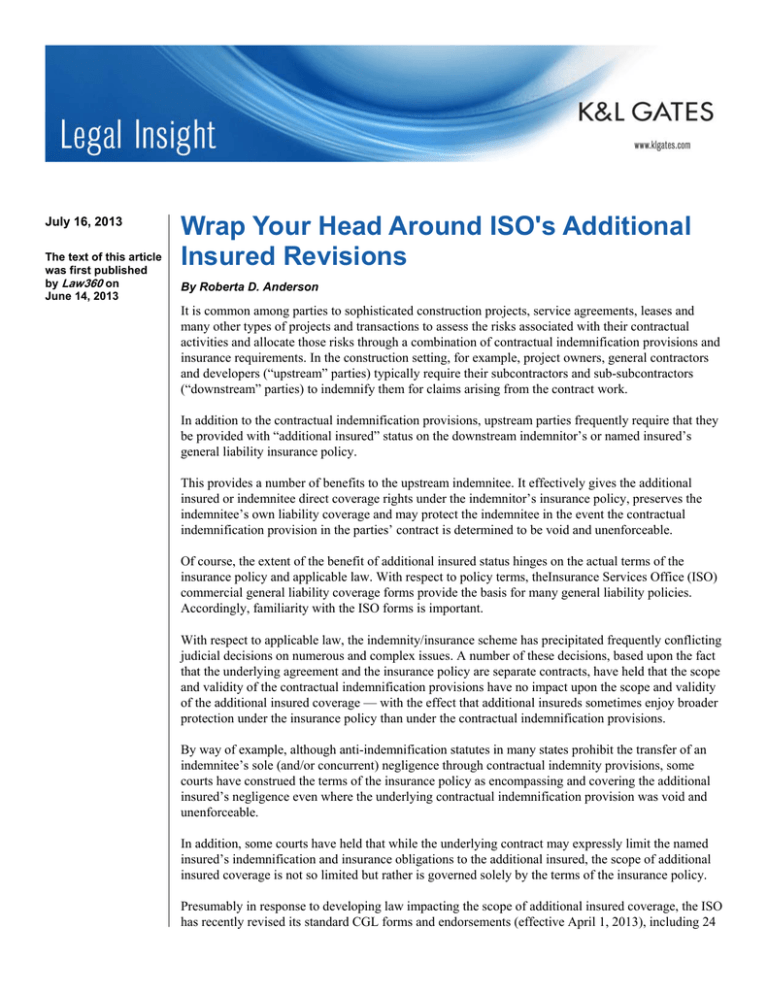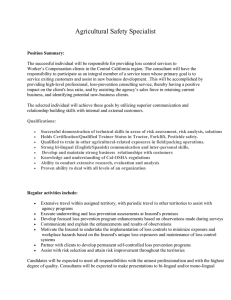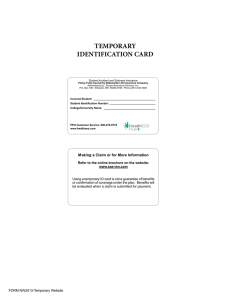
July 16, 2013
The text of this article
was first published
by Law360 on
June 14, 2013
Wrap Your Head Around ISO's Additional
Insured Revisions
By Roberta D. Anderson
It is common among parties to sophisticated construction projects, service agreements, leases and
many other types of projects and transactions to assess the risks associated with their contractual
activities and allocate those risks through a combination of contractual indemnification provisions and
insurance requirements. In the construction setting, for example, project owners, general contractors
and developers (“upstream” parties) typically require their subcontractors and sub-subcontractors
(“downstream” parties) to indemnify them for claims arising from the contract work.
In addition to the contractual indemnification provisions, upstream parties frequently require that they
be provided with “additional insured” status on the downstream indemnitor’s or named insured’s
general liability insurance policy.
This provides a number of benefits to the upstream indemnitee. It effectively gives the additional
insured or indemnitee direct coverage rights under the indemnitor’s insurance policy, preserves the
indemnitee’s own liability coverage and may protect the indemnitee in the event the contractual
indemnification provision in the parties’ contract is determined to be void and unenforceable.
Of course, the extent of the benefit of additional insured status hinges on the actual terms of the
insurance policy and applicable law. With respect to policy terms, theInsurance Services Office (ISO)
commercial general liability coverage forms provide the basis for many general liability policies.
Accordingly, familiarity with the ISO forms is important.
With respect to applicable law, the indemnity/insurance scheme has precipitated frequently conflicting
judicial decisions on numerous and complex issues. A number of these decisions, based upon the fact
that the underlying agreement and the insurance policy are separate contracts, have held that the scope
and validity of the contractual indemnification provisions have no impact upon the scope and validity
of the additional insured coverage — with the effect that additional insureds sometimes enjoy broader
protection under the insurance policy than under the contractual indemnification provisions.
By way of example, although anti-indemnification statutes in many states prohibit the transfer of an
indemnitee’s sole (and/or concurrent) negligence through contractual indemnity provisions, some
courts have construed the terms of the insurance policy as encompassing and covering the additional
insured’s negligence even where the underlying contractual indemnification provision was void and
unenforceable.
In addition, some courts have held that while the underlying contract may expressly limit the named
insured’s indemnification and insurance obligations to the additional insured, the scope of additional
insured coverage is not so limited but rather is governed solely by the terms of the insurance policy.
Presumably in response to developing law impacting the scope of additional insured coverage, the ISO
has recently revised its standard CGL forms and endorsements (effective April 1, 2013), including 24
Wrap Your Head Around ISO's Additional Insured
Revisions
of its 31 standard additional insured endorsements. Although the true scope of their effect will remain
unclear until clarified by the ISO or by judicial decision, the new endorsements clearly have the
potential to further complicate an already complex area of law and may potentially negatively impact
both additional and named insureds.
The new endorsements and developing law warrant the attention of named insureds, additional
insureds, indemnitors and indemnitees alike.
Revised Additional Insured Endorsements
The revised ISO endorsements contain three significant modifications of particular concern to
contracting parties. These revisions impact 24 additional insured endorsement forms that cover a
broad range of transactions and generally attempt to tie, and thereby limit, the scope of additional
insured coverage to the underlying contract provisions.
1. Coverage Is Provided “to the Extent Permitted by Law”
The revised additional insured endorsements now state, “The insurance afforded to [an additional
insured only applies to the extent permitted by law.” Although it is not entirely clear what the
italicized language is intended to accomplish, it clearly is attempting to address state antiindemnification laws in some manner.
At least 45 states have enacted anti-indemnification statutes that restrict, modify or invalidate
indemnification agreements in construction and certain other contracts. These statutes frequently
prohibit the transfer of an indemnitee’s sole and/or concurrent negligence through indemnification
provisions.
Even where the anti-indemnification statute would render a contractual indemnification provision
unenforceable, however, a number of courts have upheld additional insured coverage — even with
respect to the additional insured’s sole negligence.
Through the 2013 language, the ISO could be attempting to address circumstances in which prior ISO
endorsements may provide broader coverage than is allowed under the anti-indemnification laws of
certain states.
Alternatively, a better reading appears to be that the ISO is attempting to harmonize, without the need
for state-specific endorsements, the scope of coverage where the state anti-indemnification law at
issue extends to additional insured coverage. In this regard, some states have expanded their antiindemnification statutes to void contract provisions that seek to transfer risk via additional insured
coverage.
The italicized language also could be intended as a “savings clause” to preserve additional insured
coverage in circumstances in which the contractual indemnification provision is determined to be void
and unenforceable under the state anti-indemnification statute. This may be in response to the fact that
some courts have voided contractual additional insured provisions where, for example, such
provisions were “inextricably tied” to the indemnification provisions.
Whatever its intent, there are likely to be disputes over the meaning of this wording, and when
2
Wrap Your Head Around ISO's Additional Insured
Revisions
judicially tested, this language could have broad and negative implications for additional insureds.
There also could be negative repercussions for indemnitors who may face breach-of-contract claims
from indemnitees who thought they had bargained for and obtained broader additional insured
coverage.
At a minimum, the language in these new forms underscores that contracting parties are well-advised
to pay attention to, among other things, potentially applicable law, the terms of the underlying contract
and the specific insurance policy terms so that they can most appropriately structure risk transfer
provisions.
2. Coverage “Will Not Be Broader Than” the Contract Requires
The additional endorsements now state, “If coverage provided to [an] additional insured is required by
a contract or agreement, the insurance afforded to such additional insured will not be broader than that
which [the named insured is] required by the contract or agreement to provide for such additional
insured.”
The ISO has not provided guidance regarding the intent of this new language. However, it seems
likely that the new language is intended to incorporate into the insurance policy any express limits on
additional insured coverage that the parties have specified in the contract, e.g., where the contract
specifies that additional insured coverage will only extend to vicarious liability.
Whatever its intent, reference to the terms of the underlying contract documents to determine the
scope of coverage afforded to additional insureds may well create areas of significant disagreement.
Again, the additional language underscores the need to carefully review the terms of the underlying
contract and the specific insurance policy language to be used to satisfy additional insured
requirements. To the extent the 2013 endorsement is used, contracting parties should ensure that the
underlying contract language clearly reflects the parties’ intent regarding the scope of additional
insured coverage.
3. Limits Are the Lesser of the Contract Requirement or the Policy Declarations
The additional insured endorsements now state that the most the insurer will pay on behalf of the
additional insured is either the amount of insurance: “[r]equired by the contract or agreement”; or
"[a]vailable under the applicable Limits of Insurance shown in the Declarations[,] whichever is less.”
It seems clear that the intent of the italicized language is to limit the insurer’s exposure to the lesser of
the policy limits or the amount agreed to by the contracting parties. And at first glance, this may seem
reasonable. This may come as an unpleasant surprise to contracting parties, however, because
additional insureds often have access to the policy’s full limits of liability — sometimes in cases in
which the underlying contract or agreement requires that the named insured provide an amount less
than the policy’s limits.
Unanticipated changes may leave both parties exposed. To the extent an additional insured has
insufficient insurance to cover a loss, it may look to the named insured for indemnification for any
amounts in excess of the insurance limits.
3
Wrap Your Head Around ISO's Additional Insured
Revisions
Conclusion
The important takeaway to contracting parties is to pay close attention to potentially applicable law,
including potentially applicable anti-indemnification statutes and the underlying contract provisions
setting forth the scope of contractual indemnification and additional insured requirements.
In addition, contracting parties are well-advised to review the specific terms of the insurance policy
under which additional insured protection is to be afforded, including all endorsements, to confirm the
coverage terms and to understand the interplay between the underlying contract provisions and the
additional insured coverage.
Importantly, there are many different additional insured forms, and there can be significant
discrepancy in the breadth of coverage provided to additional insureds under the wordings of the
various forms. By paying close attention to potentially applicable law, in addition to the specific
contract and insurance policy terms, contracting parties may avoid potentially negative surprises, such
as unexpected gaps or potential loss of insurance coverage.
The opinions expressed are those of the author and do not necessarily reflect the views of the firm, its
clients, or Portfolio Media Inc., or any of its or their respective affiliates. This article is for general
information purposes and is not intended to be and should not be taken as legal advice.
Authors:
Roberta D. Anderson
roberta.anderson@klgates.com
+1.412.355.6222
Anchorage Austin Beijing Berlin Boston Brisbane Brussels Charleston Charlotte Chicago Dallas Doha Dubai Fort Worth Frankfurt
Harrisburg Hong Kong Houston London Los Angeles Melbourne Miami Milan Moscow Newark New York Orange County Palo Alto Paris
Perth Pittsburgh Portland Raleigh Research Triangle Park San Diego San Francisco São Paulo Seattle Seoul Shanghai Singapore Spokane
Sydney Taipei Tokyo Warsaw Washington, D.C. Wilmington
K&L Gates practices out of 48 fully integrated offices located in the United States, Asia, Australia, Europe, the
Middle East and South America and represents leading global corporations, growth and middle-market companies,
capital markets participants and entrepreneurs in every major industry group as well as public sector entities,
educational institutions, philanthropic organizations and individuals. For more information about K&L Gates or its
locations, practices and registrations, visit www.klgates.com.
This publication is for informational purposes and does not contain or convey legal advice. The information herein should not be used or relied upon in
regard to any particular facts or circumstances without first consulting a lawyer.
©2013 K&L Gates LLP. All Rights Reserved.
4






